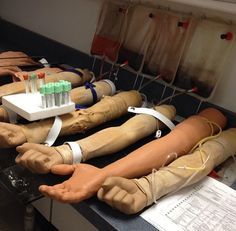Fake Arm To Practice Drawing Blood

Learning Phlebotomy with Oranges?
![]()
What is phlebotomy
Phlebotomy is defined as "the act of drawing or removing blood from the circulatory system through a cut (incision) or puncture in order to obtain a sample for analysis and diagnosis." (Farlex 2018) Phlebotomy is often necessary for a variety of tests to check organ function, hormones, medication levels, and overall health. Physicians rely on these results so they know how to best treat a patient.
Times have changed
Learning to draw blood has changed quite a bit in the last few years. I remember taking a phlebotomy class 14 years ago. We did not use mannequins to practice drawing back then. Our first experience with a needle involved poking into an orange to get the feel of pushing the needle through the skin. After the orange we went straight to human draws. We had an instructor sit beside us and walk us through step-by-step. Later when I got hired on at the local hospital, I found it was commonplace to hire new phlebotomists with no experience at all. We would train them on the job. I was quite often a new hire's very first venipuncture patient. Phlebotomy classes were not very common at this point. This practice has since been replaced by requirements for phlebotomy certification before being qualified for hire.
Teaching students with innovative technology
Two degrees later, I teach a phlebotomy program at a local community college. Times have definitely changed. We no longer learn on oranges. We also do not go straight to human draws. Our classroom has been equipped with mannequin arms. These arms have "veins" that run through them full of "blood" (water and food coloring). They look like real arms, and give my students the opportunity to practice tying tourniquets, finding and anchoring veins and pushing the needle through the skin. After drawing the dummy arms a few times, we let them draw on a human. The fake arms have been amazing in the learning process. Students can have practice following all the steps before they have the pressure of drawing on a real person. "Training arms are a great benefit for any aspiring phlebotomist or medical professional. They allow you to practice without worrying about a real human. You can hone your skills without the worry of hurting someone or missing a vein multiple times." It can "help build confidence when it comes time to perform on a real person" (E Phlebotomy Training 2018) The introduction of mannequin arms has been innovative in this field.
New ideas in teaching
One study took this a bit farther. They introduced guided imagery to their phlebotomy training sessions. An article on Sagepub.com states that after 30 minutes of practicing on fake arms, a "group received a 30-minute session of guided imagery." After this period they "demonstrated improved performance on a live venipuncture compared to the control group." (Sanders 2007) I found the concept of guided imagery as opposed to extra practice on the mannequin very interesting. As a teacher I plan to use these two concepts together to help my students best prepare for live human draws. I look forward to what the future holds for phlebotomy education.
Farlex. 2010. The Free Dictionary-Medical Dictionary. Retrieved from https://medical-dictionary.thefreedictionary.com/phlebotomy
E Phlebotomy Training. 2018. Blood Draw Procedure and Techniques. Retrieved from https://www.ephlebotomytraining.com/blood-draw-procedure-and-techniques/
Sanders, C. W., Sadoski, M., Wasserman, R. M., Wiprud, R., English, M., & Bramson, R. (2007). Comparing the Effects of Physical Practice and Mental Imagery Rehearsal on Learning Basic Venipuncture by Medical Students. Imagination, Cognition and Personality, 27(2), 117–127. https://doi.org/10.2190/IC.27.2.c
Fake Arm To Practice Drawing Blood
Source: https://medium.com/@jlmart51/learning-phlebotomy-with-oranges-e0ed2b7ba58c
Posted by: greenlyharsecy.blogspot.com

0 Response to "Fake Arm To Practice Drawing Blood"
Post a Comment